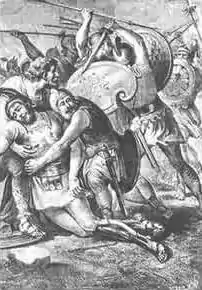Battle of the Silarius River
The Battle of the Silarius River was the final, decisive action of the Roman Servile Wars. It occurred near the mouth of modern Sele River, southern Campania, southern Italy.
| Battle of the Silarius River | |||||||
|---|---|---|---|---|---|---|---|
| Part of the Third Servile War | |||||||
 | |||||||
| |||||||
| Belligerents | |||||||
|
| Slave army | ||||||
| Commanders and leaders | |||||||
|
| Spartacus (MIA), (presumed dead) | ||||||
| Strength | |||||||
|
40,000 6 legions 4 consular legions | 50,000 | ||||||
| Casualties and losses | |||||||
| 1,000 killed (claim by Appian) |
36,000 killed 6,000 captured (later crucified) 5,000 crucified (by Pompey) Total: 47,000 | ||||||
Background
Marcus Licinius Crassus trapped Spartacus in Bruttium by building a 60-kilometre-long (37 mi) system of ditches and walls. After a failed truce, Spartacus gathered his army for battle. He ordered his horse to be brought to him, drew his sword, and slew the animal. He proclaimed to his troops that if he should win the day, he would have many horses to choose from, but if he should lose the upcoming battle and the Romans should win the day, he would not need one.
Appian wrote that Spartacus then launched several skirmishing assaults upon the Roman defenders, striking them swiftly and almost with silence. After slaying a number of the Roman guards and penetrating the Roman defenses, Spartacus and about 50,000 rebels managed to slip past Crassus' defenses, while Gannicus and Castus remained behind with the remaining 12,000 soldiers of the rebel army.
Battle
On the banks of the Sele River, Spartacus' army finally met the Roman legions of Crassus on the open battlefield. The gladiators charged at the Roman ranks, colliding with a wall of shields and swords. Though the rebels fought hard and took down many Roman soldiers, they also suffered heavy casualties in the process. Spartacus rallied his troops and led an advance against Crassus, who was watching the battle from afar mounted on his horse.
In the midst of the battle, Spartacus tried desperately to reach Crassus, killing two centurions in the process. Appian wrote that during the battle, Spartacus was severely wounded in the leg and was forced to get down on his knees. Despite his injury, the rebel leader refused to give up and continued fighting, killing several more Roman soldiers before he was finally overpowered and killed.
Aftermath
At the end of the battle, Crassus and his men were victorious, though they too had suffered some heavy casualties. According to Appian, the numbers of dead on both sides were extremely high and impossible to count. Appian pointed out in his sources that only about 1,000 Roman soldiers fell in the battle, but other historians believe that Roman casualties were much higher than that.
Spartacus also died in the battle, but his body was never recovered. Modern estimates suggest the number of rebel casualties were as high as 36,000 killed. Six thousand survivors of the revolt were captured and crucified on Crassus' orders, while 5,000 others who escaped from Crassus' troops were captured and killed by the Spanish legions under Pompey, possibly in northern Italy.[1]
References
- Brent Shaw. Spartacus And The Slave Wars A Brief History With Documents. p. 152. ISBN 0312237030.